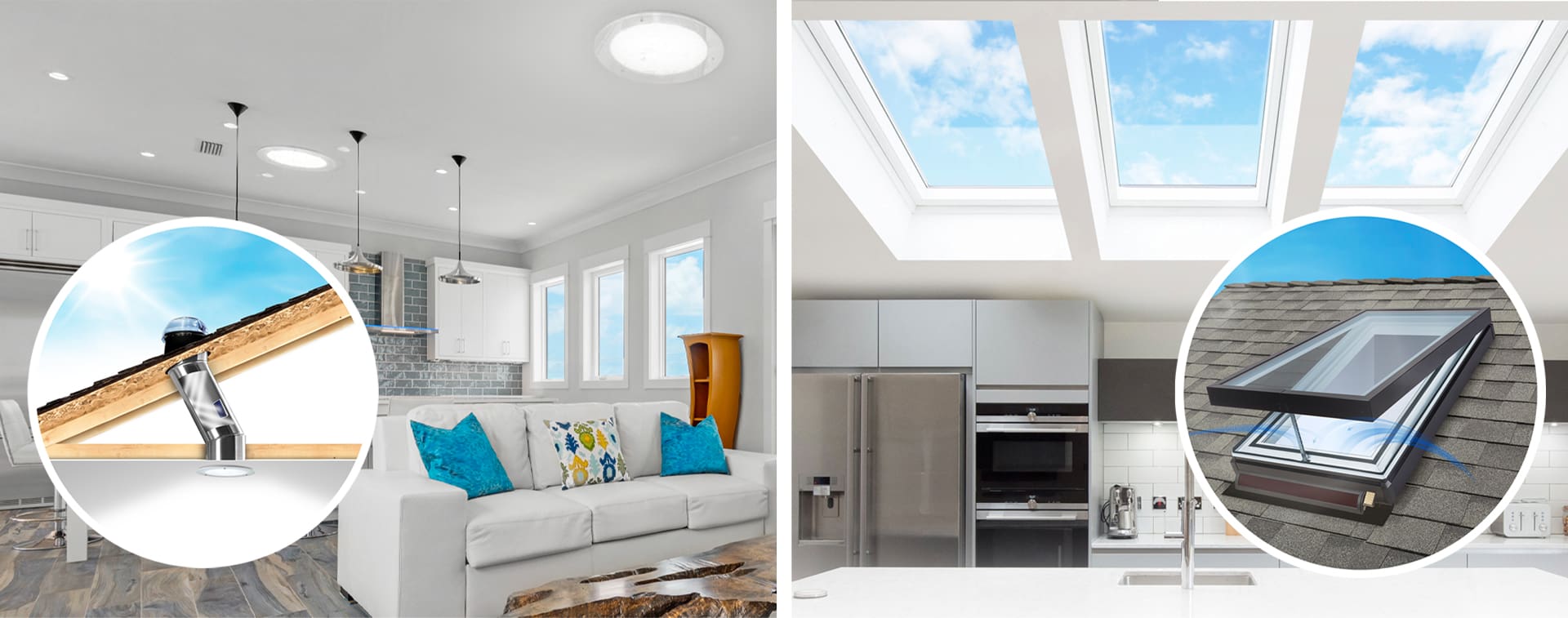The Difference Between Traditional Skylights and Solatube’s Tubular Daylighting Devices

When it comes to bringing natural light into a home, both traditional skylights and tubular daylighting devices such as Solatube systems offer valuable solutions. However, the two systems differ significantly in design, functionality, and overall impact on a space. While both approaches bring sunlight indoors, each has distinct advantages and limitations based on specific needs.
Light Capture: Traditional Skylights vs. Solatube’s Raybender® 3000
Traditional skylights act like windows on the roof, allowing light to flow directly into a room. However, this design can lead to inconsistent lighting, as the angle of sunlight changes throughout the day. Morning and evening light enters at a lower angle, while midday sun can create glare and excessive heat. Without careful placement, skylights may also yield limited light capture in some seasons.
In contrast, Solatube tubular daylighting devices are engineered to optimize light capture with the Raybender® 3000 dome. This advanced system uses a Fresnel lens to collect light from a wider range of angles, including low-angle sunlight in the mornings and evenings. The dome also blocks excessive midday sunlight, which helps provide consistent, glare-free lighting throughout the day. Additionally, the LightTracker™ Reflector enhances the system’s ability to capture light, even in darker winter months.
Skylights with Direct Light Transfer vs. Tubular Skylights with Reflective Systems
Traditional skylights are designed to allow sunlight to flow directly into a space, illuminating the room below. However, the effectiveness of this light is often limited by the skylight’s placement and environmental factors, such as shadows or roof angles. In many cases, this results in uneven lighting that may not reach far beyond the immediate area below the skylight. This also means that spaces not directly below a roof cannot benefit from the natural daylight a skylight brings in.
However, Solatube’s tubular daylighting devices feature an advanced Spectralight® Infinity tubing system that reflects 99.7% of the sunlight that enters. This highly reflective material ensures that the tube can transfer natural light over longer distances without losing brightness or color. Because Solatube systems can direct light up to 30 feet, even interior rooms far from the roof can be brightly lit by daylight. This makes Solatube more versatile in areas where traditional skylights might not be feasible, such as closets, hallways, or multi-story homes.
Nighttime Functionality of Traditional Skylights and Tubular Skylights
Traditional skylights are limited to daylight hours and provide no light once the sun has set. They act as windows to the dark sky at night, offering little functional value beyond a view. This means a system meant to bring light into your home is rendered useless nearly half the time.
Solatube tubular skylights can go beyond daylighting by integrating a solar-powered nightlight option. A soft, diffused glow emits from the skylight opening at night, keeping these spaces illuminated. This makes Solatube systems useful in areas that require consistent light, such as hallways, closets, or bathrooms, and helps reduce the need for electric lighting even after sunset.
Skylight Control and Design Options
Traditional skylights offer limited control over how much light enters a space. The level of natural light largely depends on the time of day and weather conditions, and little can be done if too much glaring light enters the home. Some skylights can be fitted with blinds, but the options for customizing the light are generally limited.
Solatube systems provide greater flexibility through dimmers, allowing users to adjust the light entering the room. Whether a room needs bright, natural light or a softer ambiance, Solatube’s adjustable system delivers versatile lighting solutions that traditional skylights may not offer. This gives homeowners control over lighting levels, much like electric lights, but without energy consumption. Additionally, Solatube offers decorative fixtures in various styles and colors, allowing homeowners to customize the look of the daylight in their space.
Installation and Energy Efficiency of Tubular and Traditional Skylights
Installing traditional skylights often requires cutting large openings in the roof, which can be invasive and time-consuming. If not installed properly, this process may also lead to complications like heat loss, leaks, or energy inefficiencies. Furthermore, large skylights can contribute to heat gain in warmer months, causing the HVAC system to work harder and increasing cooling costs.
On the other hand, Solatube’s tubular daylighting systems require much smaller roof openings, minimizing the impact on the home’s structure and reducing the potential for leaks or heat transfer. Solatube’s small footprint on the roof makes it more energy-efficient, preventing excess heat gain and keeping indoor temperatures more stable. These systems also reduce the need for artificial lighting, lowering energy consumption and helping homeowners save on utility bills.
When comparing traditional skylights with Solatube’s tubular daylighting devices, each option offers unique benefits based on specific needs. Traditional skylights provide direct sunlight and an open view of the sky, while Solatube systems offer enhanced flexibility, better light distribution, and energy efficiency.
Solatube’s tubular daylighting systems provide a more versatile and efficient alternative to traditional residential skylights for homeowners seeking consistent, controlled natural light without the risks of glare or heat buildup. To learn more about having a Solatube skylight installed in your home, contact your local Solatube dealer today.
